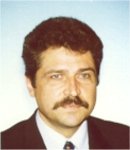Plenary Lecture
Biomedical Image Processing and Analysis by Using Artificial Intelligence
and Information Fusion

Professor Hariton Costin
The “Gr.T. Popa” University of Medicine and Pharmacy, IASI
Faculty of Medical Bioengineering
ROMANIA
E-mail: hcostin@gmail.com
Abstract: Medical imaging
mainly manages and processes missing, ambiguous, complementary, redundant
and distorted data and information has a strong structural character. The
understanding of any image involves the matching of features extracted from
the image with pre-stored models. The production of a high-level symbolic
model requires the representation of knowledge about the objects to be
modeled, their relationships, and how and when to use the information stored
within the model.
This presentation reports new (semi)automated methods for the segmentation
and classification of images of cerebral structures using an information
fusion technique based on soft computing (fuzzy logic) and specific
knowledge. Fuzzy logic acts as a unified framework for representing and
processing both numerical and symbolic information (“hybridization”), as
well as structural information constituted mainly by spatial relationships
in biomedical imaging. Our applications are mainly for the segmentation of
brain structures for magnetic resonance (MR) and CT (computer tomography)
images, based both on atlas and real data. Promising results show the
superiority of this knowledge-based approach over best traditional
techniques in terms of segmentation errors. The classification of different
cerebral structures is made by implementing rules yielded both by domain
literature and by medical experts. Though the proposed methodology has been
implemented and successfully used for model-driven in the domain of MR and
CT imaging, the deployed methods are generic and applicable to any structure
that can be defined by expert knowledge and morphological images.
Another branch of applications of soft-computing and data fusion is
represented by medical image registration, e.g. for PET and CT images. We
first apply a mutual information based registration algorithm and then fuse
the PET and CT images (taken separately or yielded by a PET-CT scanner) by
using the 2ν-Granular Support Vector Machine. The fused image contains the
properties of both PET and CT images and is an efficicient tool for image
registration.
Brief Biography of the Speaker:
Prof. dr. eng. Hariton Costin, BS in Electronics and Telecommunications
(1980), Ph.D. in Applied Informatics, MBA diploma, is full professor and
chief of the Medical Electronics Department at the University of Medicine
and Pharmacy / Faculty of Medical Bioengineering, Iasi, Romania, (www.umfiasi.ro).
Also, he is senior researcher at the Romanian Academy, Institute for
Computer Science – Iasi Branch, within the Image Processing and Pattern
Recognition Lab, (http://www.iit.tuiasi.ro/personal/h_costin.html), where he
studies image processing and analysis by using Artificial Intelligence
methods and data fusion.
Competence areas include: medical electronics, biosignal and image
processing and analysis, artificial intelligence (soft-computing, expert
systems), hybrid systems, HCI (human-computer interfaces), telemedicine and
e-health.
Scientific activity can be resumed by about 95 published papers (26 in
Romania and 69 abroad), 5 books, 4 book chapters in foreign publishing
houses, 3 patents, 2 national awards.
Research activity: 28 research reports, technical manager within FP5/INES
2001-32316 project, for a telemedicine application (www.euroines.com ; „Medcare”
project); responsible for the first Romanian pilot telemedical centre in
Iasi, (CEEX programme – research of excellence - www.mct-excelenta.ro and
for the National Programme for R&D 2007-2013, www.cnmp.ro), director for 5
national granted projects in bioengineering and (biomedical) image
processing / analysis, invited postdoc researcher at the University of
Science and Technology of Lille (France, 2002, medical imaging), invited
talks at international conferences.
Prof. Costin is a member of the I.E.E.E./Engineering in Medicine & Biology
Society (EMBS) and of other 8 scientific societies.